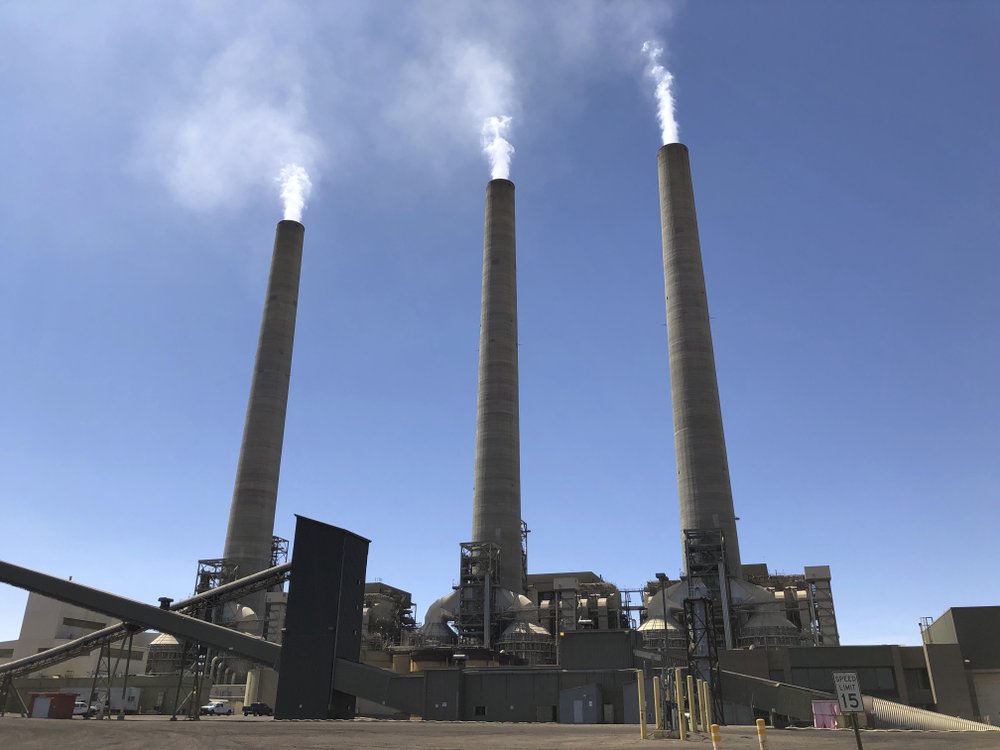
FLAGSTAFF, Ariz. (AP) — Three towering concrete stacks that were the most visual reminders of a coal-fired power plant that operated for decades along the Arizona-Utah state line came down Friday.
The 775-foot (236-meter) structures loomed over the Navajo Generating Station, a 2,250 megawatt plant that closed last year as natural gas became a cheaper source of energy. It was a symbol of economic stability in a region where good-paying jobs are hard to come by but also the longtime target of environmentalists for its pollution and reliance on fossil fuel and water.
The stacks stood as beacons in the community, lights flashing at night to guide pilots and signal to travelers that they were approaching the city of Page and home.
“I have mixed emotions because I’ve spent most of my life as a constructor, and now I’m wearing a different hat in the demolition mode,” said Gary Barras, a project management director for the Salt River Project, the Arizona utility that operated the plant. “I know personally how hard it was to design and build those stacks.”ADVERTISEMENT
A series of booms echoed through the region that includes iconic tourist destinations such as Lake Powell, Antelope Canyon and Horseshoe Bend as the stacks fell one by one within seconds of each other. Clouds of dust covered what’s left of the power plant, sitting low on the landscape before drifting away.
Evan Scott Sr. worked a variety of jobs at the power plant for more than 37 years before going into early retirement. The Navajo man put on the jacket he got for his 30th anniversary and posted up near a mutton stand to watch the stacks fall and said he was heartbroken.
“I have lots of memories with the whole plant, inside and out,” he said. “I enjoyed it and I’m proud of myself, especially for my family.”
For his daughter-in-law’s family, the reaction was opposite.
Cassie Scott grew up hearing from her grandmother about how she gave up a portion of her grazing area on the Navajo Nation to make way for the power plant but never got the electricity she was promised verbally before she died in 2013, Scott said.
The family imagined her Friday celebrating in heaven as the stacks fell sequentially.
Jon Adams watched a livestream of the demolition at his home nearby. He is part of a limited crew of Salt River Project employees who still work at the plant while it’s being decommissioned. The stacks essentially were his office as he monitored emissions.
Even when he wasn’t at work, he’d glance at the towers to gauge the fuel load based on the height of the plumes. He was preparing late Friday for whatever emotion might come when he looked that direction on his way to the grocery store.
“I don’t know what I’ll be doing after my time is up with SRP,” said Adams, who is Navajo. “I hope whatever it is is as cool as what I’ve been doing all this time.”
Environmentalists and some members of the Navajo and Hopi tribes fought for years to shut down the plant, among the largest in the West, in favor of renewable energy.
Nicole Horseherder is among them. She said Friday that she’s looking toward a future that doesn’t depend on coal and projects that are mutually beneficial to the Navajo Nation and those who pitch them.
“We don’t need to have precious resources tied up so the rest of the state can grow and prosper and our communities sit without basic necessities like water,” said Horseherder, who is Navajo.
The plant was built to power the Southwest and a canal system that delivers Colorado River water to Arizona’s major metropolitan areas. It shut down in November 2019.
The stacks came down in a way that’s similar to cutting down a tree. Crews sawed the back side of the stacks so they would fall to the northeast largely onto concrete pads where water treatment, ash handling and brine concentrator systems once stood.
Crews also gutted transformers, wiring and elevators from the first 30 feet (9 meters) of the stacks to prepare. Small blocks of concrete were cut and knocked out of the structures to weaken them. Windows and vents were removed and reinforced to keep the stacks from twisting, said Nathan Betts, construction manager for Tetra Tech, the company overseeing contractors on site.
To prevent the stacks from falling earlier, crews didn’t release the last bit of tension until Friday morning before detonating about 1,530 pounds (694 kilograms) of dynamite.
No one was allowed within a 2,000-foot (609-meter) radius of the stacks for safety reasons. The original stacks were the same size but had been reduced to 220 feet (67 meters). They came down earlier this year.
The work is part of a $150 million decommissioning of the plant that is on land leased by the Navajo Nation. The buildings that housed the boilers — what Barras called the proverbial tea kettles — will go next, he said.
The land will be turned over to the Navajo Nation within a few years but monitoring will continue for decades.
Stephanie Hansen used the last day of teaching her eighth grade class at Page Middle School to watch the demolition of the stacks and reflect on what it meant for the students. They felt vibrations when the stacks hit the ground but the booming sound was more powerful.
“I wonder what people will think,” she said. “They come here for these canyons and lakes, but if you come in the middle of the night, that’s all you see in the darkness.”
